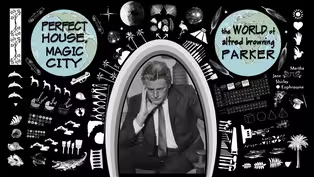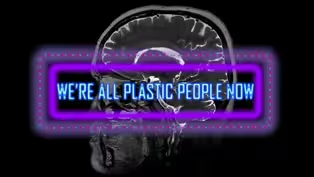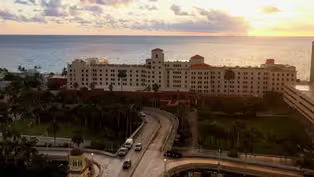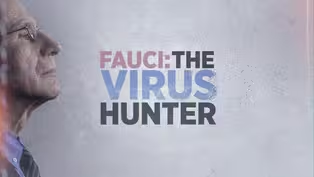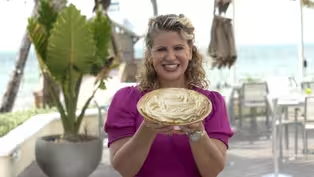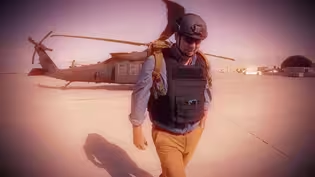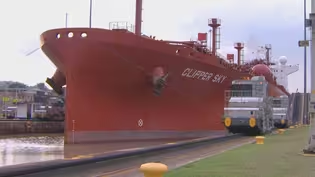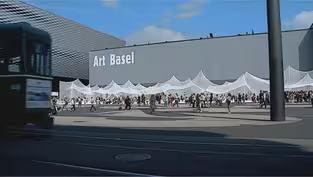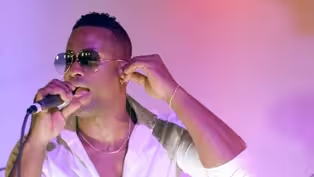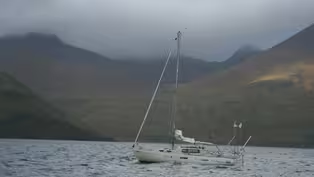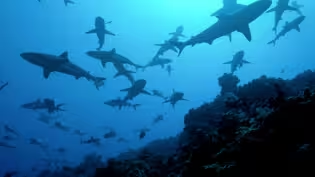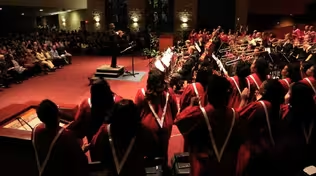South Florida PBS Presents
The Florida Keys: 200 Years of Paradise
Special | 56m 46sVideo has Closed Captions
Journey through the history of the Keys and meet the people who live there.
Celebrate the uniquely colorful and often dramatic history of our nation’s southernmost subtropical isles. This program takes viewers on a historic journey to one of the most fascinating and exotic places in the country, discovering the people and events that make the Conch Republic unforgettably offbeat.
Problems playing video? | Closed Captioning Feedback
Problems playing video? | Closed Captioning Feedback
South Florida PBS Presents is a local public television program presented by WPBT
South Florida PBS Presents
The Florida Keys: 200 Years of Paradise
Special | 56m 46sVideo has Closed Captions
Celebrate the uniquely colorful and often dramatic history of our nation’s southernmost subtropical isles. This program takes viewers on a historic journey to one of the most fascinating and exotic places in the country, discovering the people and events that make the Conch Republic unforgettably offbeat.
Problems playing video? | Closed Captioning Feedback
How to Watch South Florida PBS Presents
South Florida PBS Presents is available to stream on pbs.org and the free PBS App, available on iPhone, Apple TV, Android TV, Android smartphones, Amazon Fire TV, Amazon Fire Tablet, Roku, Samsung Smart TV, and Vizio.
Providing Support for PBS.org
Learn Moreabout PBS online sponsorshipMore from This Collection
Documentaries showcasing the South Florida community produced by South Florida PBS.
Video has Closed Captions
A documentary portrait of architect Alfred Browning Parker. (56m 46s)
Video has Closed Captions
Investigation into the hidden story of plastic and its effects on human health. (56m 50s)
Video has Closed Captions
The Historic Hollywood Beach Resort, also known as the "Grand Lady," has a famous and stor (26m 29s)
Video has Closed Captions
Explore Dr. Anthony Fauci's unique legacy in infectious diseases research. (56m 26s)
Video has Closed Captions
Michelle Bernstein tours the Florida Keys in search of local specialties, recipes and more (56m 46s)
Video has Closed Captions
The story of American men and women serving in our wars in the Middle East. (24m 46s)
Panama Canal: Prized Possession
Video has Closed Captions
Explore the history of the transfer of the Panama Canal from the United States to Panama. (57m 23s)
Video has Closed Captions
Basel, Switzerland plays host to the largest and most influential art fair in the world. (26m 58s)
Video has Closed Captions
Experience the explosion of the Latino influence on mainstream American music and culture. (57m 23s)
Red Dot on the Ocean: The Story of Matt Rutherford
Video has Closed Captions
Matt Rutherford risked it all in an attempt to sail alone around the Americas. (56m 50s)
Video has Closed Captions
Mysteries of the Coral Canyon tells the story of how sharks and coral reefs are connected. (55m 1s)
Video has Closed Captions
Everyone Has A Place is a short musical documentary featuring jazz, gospel and vocals. (26m 55s)
Providing Support for PBS.org
Learn Moreabout PBS online sponsorshipThe early pioneers who ventured to the Florida Keys encountered a breathtaking frontier.
An aqua tinted ocean brimming with conk and coral where endless flamingos filled the skies.
It's the light, it's the smell of the water.
But the settlers also faced disastrous hurricanes and unforgiving reefs where ships were wrecked by the dozens.
The pioneers, they were a sturdy lot.
You had to have something to come live in a place that was a wild outpost.
The people who arrived on these shores would go on to change the keys in many ways but the Florida Keys would also profoundly change them.
It felt exotic.
It felt a little scary.
It's about a sense of inclusiveness that I didn't experience before in my life and an openness and a feeling of you can be whatever you want to be here.
I just want to leave the legacy that was handed me.
I want my grandchildren to be as proud of me as I am of my grandfather.
These remote islands have seen dramatic, sometimes outrageous history over the last 200 years with wreckers and Cuban cigar factories producing unimaginable wealth where black Bahamians founded a proudly independent community.
The African-American history of the Keys and Key West is a story that is not out there and it needs to be a there.
An island chain where pirates and later Nazi submarines proud just off the beaches and where necessity really was a mother of invention as intrepid engineers constructed a railroad that soared high above the sea.
There's ebbs and flows on this island that are almost innumerable and Key West pivots like no other place on the on the planet pivots into what's next.
Riders and musicians fell hard for this paradise.
Beautiful but quirky, different, off beat.
We are so far from the real world that it is a chance to find those other parts within yourself.
Today, visitors come for the world-class fishing, the tropical climate, and of course, the tempting key lime pie.
They come because the Keys know how to throw a good party.
Happy birthday, Key West.
Can never enjoy getting lost somewhere like you can here.
There's also people that come here to let their hair down.
And I like to say you either get it or you don't.
But scratch the surface and 200 years of adventure await with booms and busts.
Villains and heroins, war and peace.
It's this remarkable history that makes the Florida Keys one of the most fascinating places in our nation.
Major funding for this program was provided by Where there is freedom, there is expression, the Florida Keys, and Key West.
Cultural, culinary secrets, and global flavors.
We have a passion for blending ingredients and seasonings from around the world.
On the 25th of March in 1822, Lieutenant Commander Matthew C Perry navigated the USS Shark to an island ominously known as Bone Key.
There, Perry planted the 23-star United States flag in the hard limestone riddled soil and claimed land once owned by Spain for America.
Perry's job was to survey the island and report a it was feasible to make a navy facility there.
It was a strangely uninhabited island.
Most of the Native Americans of Florida had left or died out from the seas or been assimilated into what's now the Seminoles and the Mikasukis.
So we know that by the time the Americans came to Keys, they no record of any native Americans being left here.
A paradise full of peril.
All the world's sailing through these waterways using outdated incomplete charts.
As we well know the reef runs several hundred miles and is at varying depths and varying locations and it's pretty easy to to get lost in it.
Because so many ships got into trouble sailors from the Bahamas nicknamed Conks sailed up and down the Keys working as wreckers.
And wrecking was the job of going out and patrolling the the reef line looking for ships in peril and your job as a wrecker was to approach the ship and offer your assistance in getting that ship safely off the reef or if that wasn't possible then to rescue the cargo and rescue the crew and for that you were paid a percentage of the cargo.
With so many ships wrecking the government decided to take action.
And by 18 twenty-seven four brick lighthouses shown brightly through the night at Cape Florida, Sand Key, Key West, and in the dry Tortugas.
Yet it wasn't enough.
Got hundreds of miles worth of reef line that is not marked yet.
Ships continue to run a ground on the reef.
Words spread up and down the eastern seaboard that wrecking in the Keys was dangerous work but it could make you rich.
It was a major source of income.
When New Englander Corina Brown arrived at Key West, she marveled that a wreck brought in last week was worth one 40, 000 dollars.
But the Florida Keys could be tough on its settlers.
It was a watery wild west.
We've been subject to piracy from particularly Cuban piracy at that time.
To combat piracy, the West Indies squadron was born in 18 twenty-three.
Headed by Commodore David Porter of the US Navy.
The old anti-piracy squadron was using ships that were too big.
Couldn't get in and out of these narrow channels, couldn't get to the coast of Cuba.
So Porter devised a strategy where he brought in shallow draft vessels and barges and really started making a dent against the pirates.
But Porter had to fight more than just pirates.
Now Porter's problem was an enemy that they had not anticipated.
And that was the Keys mosquitoes.
Porter's men were ravaged by yellow fever.
One victim of the dreaded yellow fever was the head keeper of the Key West Lighthouse, Michael Maverty.
After his death, his wife Barbara became the keeper which was highly unusual at the time.
Climbing steep stairs each night in her long skirts, she kept the light shining even through hurricanes.
Six miles away on tiny sandkey.
A fellow widow, Rebecca Florida, also kept the lighthouse.
One of the few female keepers hired by the government.
The women are very on in building communities.
They're also very active in their churches and they're also physical builders.
There's a lot of physical work to be done.
On Key West, early leaders did their best to establish some sense of order as it was an island with practically no law enforcement.
People seem free to do as they please.
Men were even getting into deadly duels.
But this tropical frontier did not offer freedom to everyone.
Their slavery happening from from the minute Key West get settled.
There are slaves on this island.
Certainly Key West wasn't you know this this paradise of brotherly love.
I mean we need to be real about that.
Free people of color also faced harsh regulation and curfews and were eventually outloamed from moving to Florida.
In the 1850s, about 20% of Key West black population was free including a free black woman named Hannah Brooks who had arrived from Saint Augustine.
A gifted nurse and midwife, one settler, recalled that she won the affection of all.
Hannah Brooks delivered most of the babies on the island.
White saw no contradiction in accepting medical care from a black woman and enslaving her sisters and her brothers.
Yet despite all odds, the black population persevered and created their own legacy.
You cannot underestimate the black contribution to the Florida Keys.
It's American history.
You know, it belongs to all of us.
You had Bahamians.
You had from all over the Americas.
You had even people from Cape Verde Islands and if you were emancipated, you had to been taught a skill.
You know, and that was British law.
The Bahamian immigrants that came to Key West, they're all skills.
They help build Key West.
And in the nine century, one free black man literally kept Key West fed on an island where it was almost impossible to farm.
There is no top though.
There's no alluvial soil.
It's on limestone rock and noone since has ever farmed anything to that magnitude on Key West.
Sandy Cornish established a farm on land that belonged to his wife Lilia.
At the time where women lawfully weren't allowed to own property.
But here an African-American woman owns two lots in Key West.
Key West had long suffered from a shortage of fruits and vegetables but Cornish was an innovator.
So, he knew to mix the seaweed with the horse manure because there was no vegetation enough to collect to make compost.
What he grew on the farm, all kind of tropical fruits like your sugar apples, your soursops, your guavas, he grew great melons, cabbages, sweet potatoes.
Sandy Cornish had been born into slavery in Maryland.
By the time he was brought to Florida, he'd been in bondage for 40 years.
At a time when the average life expectancy was only thirty-five.
Just to enter Florida, the couple had to be sponsored by a white person.
Lilia as a free black person was restricted from going into Florida.
So fundamentally, she had to put herself into slavery where she never was in order to be by side.
So, they had to work off all this money and stuff like that to buy their freedom.
Freedom came at a high price.
$3 thousand equal to tens of thousands today.
Later, their freedom papers burned in a fire, seizing on that opportunity.
A group of men tried to capture Sandy.
So, they were going to grab him and and sell him in a market in in New Orleans.
He takes a knife and cuts his hamstring.
Rob off, right?
Bam.
He stumbles a little bit.
He goes, you still want this?
And then he cuts off his finger.
Puts it in his mouth like a cigar and the crowd is shocked obviously you know so basically he's no good anymore anything to be free you know and that was the point when Sandy was nearly 50 he and Lilia started over moving to Key West the nurse Hannah Brooks may have tended to his wounds Even as free people, the Cornish is still face very restrictive laws.
Despite the discrimination, Sandy's fruit and vegetable trade was a huge success.
The Cornish Farm became a local institution.
So, he's making money.
He's making oodles of money.
Sandy was now a leading citizen and helped to build a black church.
He's a very influential guy.
He's also African American, alright?
Let's not forget that.
So, you you have a mindset of people who basically Uh didn't accept African Americans as people in the beginning anyway.
So, he basically had changed a lot of people's mind because he had an astute knowledge of business.
His success story appeared in newspapers across the nation.
And his rise to iconic figure is now being set in motion.
Although Florida would join the Confederacy during the Civil War, Union Forces held Key West.
Black Key Westers served in the Union Army.
And then after Abraham Lincoln was assassinated in eighteen sixty-five, President Andrew Johnson sent a group to the South to survey the effects of slavery.
The group traveled to Key West because word had spread about Sandy Cornish and this remarkable community.
They say in a report that the Most successful community, African-American community in the south was Key West.
So they're arguing at this point to Andrew Johnson saying no African Americans are equal to to white people because we have this community in Key West you know that proves that if left alone they could survive.
They could prosper and and that was the the major take home message that they keep hammering to Andrew Johnson to do the framework for reconstruction based on the community in Key West.
Doors started to open for black achievement.
Key West elected not only a black sheriff Charles DuPont but a black county judge James Dean.
Famous abolitionist and writer Frederick Douglas even visited the island and a school for black children was established in his name.
The school opened in 1870 located in today's Bahama Village, a neighborhood with deep roots in Key West history.
While Sandy supplied Key West throughout the Keys, both blacks and whites learned to work the land.
They farmed the land and they farmed the ocean.
Pioneers grew key limes and at one point, pineapples were very profitable.
85 percent of the pineapples consumed in the United States were produced in in the Florida Keys.
Until a blight destroyed the industry.
Despite Jim Crow laws that reversed the racial progress of reconstruction, black settlers still saw opportunities in the Florida Keys George and Olivia Atterley.
They came from the Bahamas about 1890.
They moved to Keys better known as Marathon and they bought George bought thirty-two acres of land.
George and Olivia built an unusual house of tabby homemade concrete.
Today, their house, the Adderly house is the oldest house in the Florida Keys that's outside of Key West and it was built in the style of a classic Bahamian structure.
The Adderly home became the cornerstone of a independent black community.
There was about five families living at what became known as Adri Town and they were farmers, fishermen, and spongers.
They made charcoal.
The spongers that really became part of this larger industry were largely people who had been enslaved and had been taken from Africa and released by the British government in the Bahamas when the slave trade became illegal.
In the early nineteen hundreds, millionaire Henry Flagler wanted to build his railroad across George land utterly made Flagler strike a deal.
He basically made the Flagler Railroad stop at his property and marathon.
George was smart enough to know that if they had a train stop there, they could get their products, you know, to market better.
There is so much black history in the Keys still waiting to be discovered just beneath the surface including one of the Florida Keys most famous wrecks.
A slave ship named the Guerrero that went down in 1827.
When they were chased onto the reef, the ship sunks.
There were 561 of them on it.
41 of them died that night.
Divers with a purpose is working to find the side of the wreck where so many Africans lost their lives.
A 16-year one theory is that the ship sank North of Key Largo in today's Biscayne National Park.
We were promised that if if and when it was found that we as African Americans would be the first one to be able to document that rest and for a lot of people it was about being where the ancestors lay and just being a part of history.
We need to know what happened to these folks and and put this thing to rest.
A lot of African Americans don't want to talk about slavery but you have to know your history.
You have to know where you've been so you can know where you're going.
To full understand the Florida Keys story, you also have to turn to the history of Cubans and Jews.
In the late 1860s, a New York tobacco trader set his sights on Key West.
Samuel Seidenberg saw big opportunity in the tiny distance between Key West and Cuba.
Then the cigar capital of the world.
A few years later another tobacco man came to town.
This one from Cuba.
Eduardo Hidalgo Gato.
On the surface the man had little in common.
Other than their line of work.
Seidenberg was German.
Gato a Cuban of Spanish heritage.
Seidenberg was Jewish.
Gato a Roman Catholic.
Two entrepreneurs represented two very different communities that would transform Key West like a tremendous tide the Jewish community in Key West had a huge impact on what we think of as Key West today what we think of as Keys history Key West had the first Cuban American community in the United States despite their differences Key West Jews and Cubans had something in common they were both people living in exile united in their hunger for freedom the Cubans saw in Key West a place where they could come to plan the struggle for Cuba's independence.
Jewish immigrants had left their homes in Europe due to persecution.
Before the 1870s, only a modest number of Cubans and Jews made their home in the Florida Keys yet Key West began to earn a reputation for tolerance.
It was a multicultural place.
It was a multilingual place.
Close to 50% of people living in Key West around the 1890s were either Cuban born or had at least one Cuban parent.
It was a town, you know, of immigrants.
So Jews that were coming to Keys, we're coming to a place that didn't really look like a lot of America.
But while those immigrants might possibly find a haven, jobs were another story with the wrecking business in decline.
Key West no longer had a profitable industry.
Local shops produced small batches of cigars.
But for decades Cuba had dominated the luxury cigar industry.
All that would change.
People continue to be enchanted by cigars and it's always told as a Cuban story.
But more recently researchers have uncovered that Jewish entrepreneurs also played a pivotal role.
Samuel Seidenberg capitalized on structure that had gone into place in the 1860s that made it financially advantageous to produce cigars domestically in the United States.
So he moved to Key West, established a huge manufacturing base here.
Meanwhile, the bloody 10 years war erupted in Cuba.
An effort to overthrow Spanish rule once and for all.
Rebel sympathizers like Eduardo Gato relocated their cigar businesses to the closest American port city, Keys The Cubans who came were from all walks of life.
They were rich and poor.
And even the women worked in the tobacco factories here.
They could maintain a very close connection to the homeland.
Remember Key West at the time was not connected to Florida's mainland.
While in the rest of the Florida Keys people made their living by farming and fishing.
Key West became the nation's chief producer of cigars using Cuban tobacco leaves.
The cigar industry really was the economic engine in starting in the eighteen sixties and then running through the eighteen nineties.
Cigar money flooded the island.
Samuel Seidenberg made a fortune worth nine million in today's dollars.
Eduardo Gato built himself a mansion on Duval Street.
He created the island's first street car line and built 40 cottages to houses workers.
A neighborhood they called Gatoville.
But the cigar industry wasn't the only thing imported from Cuba, there were also revolutionary politics and a revolutionary leader.
The period of the 1880s and the 1890s when Jose Marti was here organizing the Cuban rebels.
Jose Marti was a famous activist and poet who wrote verses that were turned into beloved songs.
Verses still sung by Cubans today.
Both Gato and Seidenberg invited Marti to speak at their cigar factories.
In Marti, they recognized a leader who was fighting not just for Cubans as Marti said but for the the rights of all people.
He identified the sense of Cuban exile which he hoped would be temporary with this longer, deep historic sense of Jewish exile.
Jews like Louis Fein lent their support and contributed money and they participated in smuggling operations that delivered arms to the rebels.
Louis Fein, he was not an rabbi but he was the the facto rabbi for the community.
He was the the religious leader.
It was his family that told the story about collaboration with the Cuban revolutionary fighters under Jose Marti and I thought, you know, that's probably my great grandfather was friends with George Washington kind of story and and I I I didn't buy it initially.
That particular story is a great example of something that not only turned out to be true but turned out to be a much bigger story than the family knew.
On Duval Street factory owner Tedoro Perez introduced Jose Marti from the balcony of his own house.
A place that would come to be known as La Terraza the Martis, Martis balcony.
Jose Marti later wrote in a letter I can't deliver from my heart as I wanted to all the tenderness the just pride the gratefulness that in the name of our country we all owe to the Cuban immigrants of Key West Key West has always been a symbol of freedom and hope for the Cuban people Spain did not look kindly on Key West supported the Cuban rebels in one instance a Spanish newspaper editor challenged a pro-independence Key West journalist to a duel and when the great fire reduced much of Key West ashes in 188-six, rumors flew that Spanish agents were to blame.
In 1898, the United States joined the fray.
Soon Teddy Roosevelt's Roughriders were sailing over to Cuba for the ten week long Spanish American War.
Spain signed a treaty and by nineteen oh two, Cuba was truly free.
Cubans in Key West rejoiced at this victory at the same time, Keys fortunes were beginning to crash.
The cigar making industry was largely moving to Tampa.
It was easier to transport the finished cigar from Tampa than from Key West.
It was the kind of downfall of the cigar making industry that started to push Key West into into a depression into an economic downturn.
You talk about you know the roaring twenties but the 1920s in Keys were really really hard times.
Yet the story of the Cubans and the Jews doesn't end with the death of Key West cigar industry.
The economic difficulties of 19 20s Key West coincided with a period of real anti-immigration hysteria, anti-Semitic hysteria.
In Germany, something called the Nazi Party was gaining support and here at home in idealistic Key West, the Ku Klux Klan was on the rise.
At the same time, the US government drastically cut immigration from the very countries that Jews were hoping to escape.
Because of various legal poles they would often go to Cuba and then try to come from Cuba into the United States.
A new kind of smuggling exploded.
This time it wasn't weapons.
It was people.
Those smuggling routes were kind of reopened in the service of you know bringing Jews to to safety in the United States.
And the community here had access to a series of underground kind of chambers and even a tunnel system that connected some of them in in Old Town Keys West.
Both Cuban and Jewish smugglers ferry Jewish refugees across the Florida Straits.
They landed not only at Key West but also on Summerlin Key, Long Quay, Marathon, and Big Pine.
There was the smugglers who were sort of following the Higher Gods Law, there were also a lot of smugglers who were just doing it to make a buck at that time.
Once again, Key West served as a sanctuary.
Some of the smuggled Jewish refugees traveled north to reunite with family members.
Making the journey often not by but by train because now linking the Florida Keys to the American Mainland was an engineering marvel, the overseas railroad.
In 1902, an engineer set out from Miami with a crew of men.
Their goal, they were looking to do the impossible.
Build a railroad to Key West.
Initially, the only way to get down to the Keys especially in the 19th century was by boat only.
There was no road to connect the keys to the mainland at all.
William Chrome had been hid by Standard Oil Millionaire Henry Flagler to help him fulfill a dream.
He decided that State of Florida was an undeveloped frontier where he could build a chain of hotels and make Florida the Riviera of the United States.
Chrome reported to Flagler that building a railroad to Key West through the Everglades would never work.
Better to take it through Key Largo.
I don't know that the federal government could have afforded to build the bridges in the Keys at that time.
Um there would be question as to whether or not we would be here today if it wasn't for Henry Flagler.
Well, some people call Flagler's folly, the railroad never made money.
Other people called it the one of the greatest engineering feats of American history.
You're having to create 42 bridges over 17 miles of open water and of course, in those days, that was an extraordinary accomplishment.
Construction on the railroad began in 1905 and after all his hard work surveying for Flagler, Chrome thought he deserved the top job, chief engineer but the boss hired someone else.
Even before reaching Key Largo, engineers discovered a large body of water where they expected to find land, they named it Lake Surprise.
A surprise that added another 15 months to their schedule.
Flagler employed around 4000 workers who were often inventing equipment to help them push through mangrove swamps and coral rock and build across waterways.
The company installed a headquarters in the Middle Keys called camp number ten in what is now known as marathon.
Flagler had forbidden alcohol at the work camps.
So a ship named Senator opened as a bar and a brothel.
By nineteen oh eight the track extended from Miami to Night's Key Dock in Marathon.
Here Flagler's steam ships could meet passengers and whisked them away to West and Cuba.
Tourism remained at the forefront of Flagler's plans.
Henry Flagler connected not only the Keys to the mainland but he developed resorts up and down the Keys.
But in 1907 there was a problem.
Flagler had been dredging material from the ocean floor to create land for the final station at Key West but the Navy swiftly put a stop to this.
Flagler ordered all works south of Knights Keys stopped.
I the company laid off workers.
It was a nerve-wracking time.
Chrome tired of playing second fiddle quit.
For nearly 2 years, Key West and Flagler's crew waited to see if they would get a connection to the rest of America.
President Theodore Roosevelt hadn't wanted to overrule the navy.
It finally ended just all of a sudden.
Flagler won the standoff.
South of Marathon, engineers and workers had the massive task of building four bridges across seven miles of ocean to take the line the rest of way to Key West.
That same year, the chief engineer on the project died.
The company begged Chrome to return and he did so that an ailing flagler could see the project completed.
On January 22nd, 1912 Henry Flagler got aboard his private car the Rambler and came down to Key West and so at the open in in 1912 wasn't really complete now the first passengers rode across the many bridges in amazement nothing on either side of the tracks but miles of sea Chrome had made sure that his 82 year old boss made it to Key West now I can die happy Flagler said Finally, the keys were connected to the mainland.
The railroad brought immediate changes.
Male arrived every day at 8 o'clock.
It brought this consistency and a lot of the communities began to move away from the edges of the island and closer to the railroads.
Tavenir is a perfect example of this.
You didn't have to worry so much and and and life wasn't such a struggle.
Tourism did not take off as Flagler had hoped but one local lifelong Keys resident remembers stowing away in one of the trains box cars.
So about nine o'clock, a little friend we used to sit on the corner of the Wall Street and then all of a sudden this guy come he say tonight is a big train going north and full of pineapple that he had come from Cuba.
We look at each other.
Let's go to Miami.
The band of friends did get caught but only once.
They got me off a marathon.
We all had to get off so we say how we going to get back to Key West now.
In the 1920s, Americans were falling in love with cars.
To encourage people to drive from Miami to the Keys, work began on Cartstown Road.
By 1928, you could drive to Key Largo.
If people wanted to go further though, they had to take a ferry.
The road would stop, you'd hop on a ferry with your car, continue on, and then get back on a road and go.
To avoid the ferries, people could drive on railroad bridges even if that wasn't strictly allowed.
One company even enticed people to do just this.
Out to sea in an automobile on a road through the Atlantic Ocean.
And what Chevrolet was to achieve is saying their ride was so comfortable that you could forget using the ferry.
You can actually just drive over the train tracks instead and you wouldn't feel any of the bumps because it was such a smooth ride so you can forgo the unfortunate ferry ride.
But the most famous couple to reach Key West in that era did not arrive from the American mainland.
Ernest Hemingway was travelling from Cuba with his second wife Pauline Pfeiffer an accomplished journalist in her own right.
While the two met in Paris the island where they now found themselves could not have been more different.
It was rough around the edges.
It was prohibition time.
A hub for rum runners like the notorious Spanish Marie.
Hemingway was in on the action.
He too smuggled liquor from Cuba and frequented the Speakeasy owned by his friend Joe Russell.
After prohibition ended, Hemingway suggested Russell call his bar sloppy Joe's and became one of its best customers.
The men treated drinking like a mission.
By 1931, Pauline's rich uncle had bought the couple a mansion on Whitehead Street.
Hemmingway developed a routine of riding, drinking, and fishing.
Usually on his beloved boat, the 38foot Pilar.
Then came Labor Day 19 thirty-five, the end of summer, humid and quiet.
In the Upper Keys at the Caribbean colony sipped cocktails.
In Key West, Hemingway hurried to secure the Pilar.
As night fell, all of the keys, especially Islamarada in Key Largo hunkered down for a hurricane.
The keepers at the Alligator Reef Lighthouse watched the seas below in horror as a wall of water swept towards land.
People clinging to lime trees which have you know big long thorns in them.
They're just clinging to thorns to survive.
Body were everywhere.
The entire Caribbean Colony Resort and all its guests vanished.
At that time, the railroad was being converted to the overseas highway and there were several hundred World War one veterans working on it and the supervisor that did not take the hurricane seriously all and did not provide an evacuation plan until it was too late.
Hemiway arrived shortly after the hurricane and he toured the devastation to plus veterans were lost to that hurricane and as a world where one veteran himself, he came up here and really took offense to the way things were being handled.
You know, there were delays in getting medical attention for those who did survive and ultimately, they couldn't get personnel in here quick enough to move people out in body bags and caskets.
He wrote this skating essay and he lobbied congress.
The writer's passionate words drew national attention to the hurricane's devastation.
Upper Keys buried their dead and slowly rebuilt.
The overseas highway was finally completed and all the keys were easier to reach.
Henry Flagler's railroad tracks and bridges had been converted into the bed of the highway.
After World War two which saw huge navy presence and Nazi submarines lurking offshore, sports fishing became a big draw.
Even President Harry Truman and his wife Bess would cast their lines.
We're always blessed to have a lot of bone fishing and I mean a lot of bone fish and no small degree a great population of tarpon as well.
I always mention Ted Williams because in no small way, he put Almarada on the map when he started coming down here in the early fifties.
He was as big a name as it was in sports and he's also an incredible bone fishing and tarpon fisher.
And while most boat captains in the Florida Keys were men, women started earning their captain's licenses too.
Captain Bonnie Smith and Captain Frankie Albright gained excellent reputations as fishing guides as did their sister Beulah.
Over time, the three laid lost sisters became local legends.
By the 19fifties, the upper and middle Keys experienced a true tourist boom and it wasn't just fishing that attracted people.
There are more than 2, 000 shipwrecks that we know of in Florida Keys waters because of the way our reef is set up around these islands.
Art in the Keys, we consider him really the father of modern treasure diving as well as one of the first purveyors of recreational diving here in the Keys.
They definitely sparked other people's interest in diving treasure.
Not a lot of people were doing it at that time because it was so cumbersome to use standard diving equipment but with the open bottom helmets, there started to be more interest in diving so much though that by the nineteenfifties, Florida had to actually enact new legislation because there was this craze of treasure diving all throughout Florida.
Another treasure hunter, Mel Fisher then discovered an even bigger home, the Spanish Galion Ato with gold, silver and emeralds worth many millions of dollars.
Even without Spanish treasure, the Florida reef with its spectacular tropical fish was becoming an attraction.
The reefs in Florida are the only coral barrier reefs we have in North America.
They're the only ones we have.
They're important because they provide coastal protection to those of us that live on these low-lying islands.
The nineteen eighties were a difficult decade in the Florida Keys from the ecosystem perspective.
We started seeing signs that there was trouble.
Establishing Florida Keys National Marine Sanctuary really set the mark that this is a national treasure.
This is a special place and provided a whole host of protections for these natural resources.
But there is still work to be done.
Fangman recalls an interview that stuck with her.
I was behind the camera while a 16 year old relatively new diver was being interviewed.
She'd been diving for 2 years.
She was interviewed and asked to tell us about your experience diving these reefs.
And she proceeded to describe how she had watched the reefs decline.
2 years, 16 years old.
We need to do better than that.
And my goal, my hope, is that when she's my age, she is instead bearing witness to this thing turning around.
How we recovered these reefs.
On Big Pine Keys, the National Key Deer Refuge protects the unique tiny deer only found on that island and organizations like captains for clean water are trying to ensure that the next generation like Hemingway can still fish here.
I think the remoteness of it attracted many writers and it was a way that they could really get away from the world that they normally lived in.
There were many who followed in the footsteps of Hemingway.
He consciously tried to apply the rules of journalism to the principles of fiction.
You know, short words, short sentences, short paragraphs, declarative sentences.
The way he is able to create a moment in a scene without giving too much interior you know Hemingway's famously said that a story should be like an iceberg, 90% of it is underwater out of sight I think all of that has been a part of his influence on my writing he's talking from a certain time a certain period which is not to say I accept that as as a modern writer or as a teacher as a woman but that I take note of it so I think that in terms of Hemingway and his misogynistic perspective he's a marker of time and when we read him now we get to see what progress if any there has been in literature what progress there has been in the way we portray women or people of color More riders arrived in the 1930s.
Elizabeth Bishop was one of our most important 20th century poets.
Bishop who would later win the Pulitzer Prize was just 25 when she first visited.
The New Englander found Key West Exotic.
The town is paper white, she wrote, flake on flake of wood and paint, the buildings faint.
In the depression, real estate was cheap.
She bought a house and moved there with her partner, Louise Crane.
She knew Pauline Hemingway, now divorced.
The women went out to Sloppy Joe's where they danced the rumba and sat dresses.
Another of bishop's friends was the playwright Tennessee Williams.
A young musician was also writing the Keys very own soundtrack.
I mean, the greatest thing ever written about Keys West is Jimmy Buffett's song, Margaritaville.
That's that's the getting lost in in Key West song.
Jimmy was definitely a part of this time.
He came down and he started playing and we'd hear him around town.
He was our local celebrity.
He was part of that old Key West.
Key West was amused for a much loved children's book author too.
Shell, Shell Silverstein.
He was another one that you would see just everywhere you go.
There is a place where the sidewalk ends and before the street begins and there the grass grows soft and white and there the sun burns crimson bright and I think, god, that sounds like Key West.
I think it's fascinating to have this new cohort of women writers down here.
Judy Bloom and Ennie Dillard and Ann Beatty after you know the legacy in the 70s of the guys chasing Hemingway's ghost Hunter S Thompson, Tom McGuin.
I think it's really interesting that the way Key West works now.
It seems to me that it's also this place for readers and want to be readers to go and paint homage to some of the literary history that's there.
Today, many of the houses are lovingly cared for.
This wasn't always the case.
After the boom years of World War two, the city of Key West slid into a slow economic decline.
The other Keys were drawing in tourists with fishing and diving and roadside attractions.
Even the dolphin who starred in Flipper but in Key West, the party was over.
The Navy was was pulling out at that point.
I moved down in seventy-five.
This town was shut down.
Key West was an island in need of resuscitation.
One community decided to give it a chance.
In the 1970s, we had a big influence of gay business owners moving down here and opening businesses and buying up all the property and fixing it up.
And in the 19seventies, there were few places in America where gay men and women could live openly without fear.
Key West wasn't perfect.
One night, a group attacked fame rider Tennessee Williams.
Yet the sense of greater acceptance was real.
I was a very terrified young gay man.
I wasn't out to myself.
I came when it had already, there was a certain sense of acceptance.
As Key West started to pull out of its financial slump, concerned residents saw another urgent problem.
The island's precious architectural heritage was under threat.
Paint was peeling off the Grand Victorian mansions, cigar makers cottages were crumbling.
We had a lot of the gay writers come in and they put their money in these buildings.
The city got a much needed face lift.
About nineteen seventy-6 7-seven, a group of concerned businessmen and City Commission at the time decided that they wanted to revitalize Duval Street and Bahama Village itself.
It was also an effort to tie us in more closely to our Bahamian roots.
The rich and famous began to take notice of the island's revival.
Then all of a sudden actually Calvin Klein came down and the reason why he loved Keys is because noone bothered him.
It was such a small type community.
It was a magic time.
That man revived Key West nightlife before long they took the party to the streets.
That initial fantasy fest.
This kind of really inspired parade that people just put together with small floats and costumes and everyone was out on the streets watching it.
But this was not an international this was a local thing.
There were six women coming down the street.
They're wearing top hats, red shore, little tiny red blurry shorts that had a cane and cap shoes and they were tapping their way down the street topless and probably the youngest in the group might have been sixty.
They had the routine down and it and everyone just loved them, applauded them.
That local celebration turned into a yearly tropical festival to rival New Orleans Mardi Gras or Rio's Carnival.
Optimism flow through Key West like a welcome breeze.
The island elected one of the country's first openly gay mayors Richard Heyman but in the early eighties, the good times faltered, its most beloved gay resident, Tennessee Williams died and Key West faced a sobering new reality, the AIDS crisis.
Eventually, this led to an AIDS Memorial and the first Key West Pride Parade.
While the gay community could unite openly on the streets over in Cuba, people worth thirsting for freedom.
And then in in that time, the Mariel Boatlift started and we would just get into the point where our tourist industry was coming back to life.
Dictator Fidel Castro was allowing Cubans to escape from the Port of Marial.
Boats left South Florida to bring back family members and other refugees.
At this time, tourism had been picking up.
Plans were a foot to modernize the overseas highway with a new and improved seven-mile bridge.
Then, in 1982, tourist traffic came to a halt.
Nobody can get out of the keys.
It's it's they're backed up all the way in the Key Lago.
It's twenty-three-mile traffic jam.
I called the police chief.
He said, I I haven't heard anything.
This was during the war on drugs.
So, the government decided to erect a basically a border checkpoint at the top of the Florida Keys.
So I called the office and that Congressman Facell on the phone and I asked him, I said, what is going on?
I said, we are we are getting killed here.
People are cancelling reservations.
That border checkpoint created one of the largest parking lots ever seen.
Everybody who's being stopped is being asked to show their identification as if they were leaving a foreign country.
My phone's ringing off the hook.
People want to know what's going on.
Why can't they get out of here?
And and I'd like to know, you know, why you all putting this up.
They want to look for drugs but they're saying it's that they're looking for illegal aliens.
Of course, this becomes a international story and it's great to come to visit the Keys but you can't, once you get here, you can't get out.
So, the mayor of Key West, Dennis Wardlow.
Um they come up with a great plan.
And I said tomorrow at noon, we're going to succeed and become the concrete public.
If they're going to treat us as a foreign country, we're going to become a foreign country.
Mayor Wardlow ordered the American flag to be lowered at Key West.
As part of the gag, the New Republic declared war on the United States by hitting a military serviceman over the head with a baton of Cuban bread.
And right after that, within a minute, I surrendered and I think then I asked for a million dollars in foreign aid.
We raised our flag and then, you know, everybody liked everything else.
We start celebrating.
The Florida Keys adopted the Conk Republic flag as a quirky badge of honor.
Later when Monroe County Mayor Willamina Harvey met the Queen of England, she presented the queen with a conk shell.
The 19nineties ushered in an era of growth and prosperity.
Some travelers took the scenic route vacationing in the city of Marathon or on the quiet island of Sugarloaf.
On Key West, visitors lined up to see the legendary drag shows.
The house known as Lateraza the Martis where Cuban revolutionary Jose Marti once gave a stirring speech was now called Latida.
A cabaret where drag stars sparkle in sequence.
I mean we are I have all ages at my show in every walk of life.
I've had a priest, a nun, a rabbi, multiples.
They all come.
They have a great time.
I try not to offend too much.
Do you believe As the new millennium dawned, Key West celebrated gay pride with a flag the length of Duval Street, one in a quarter miles long.
In 2015, the island saw its first same-sex wedding and in twenty eighteen, Key West elected Terry Johnston, Florida's first openly lesbian mayor.
Come.
Be who you are.
We'll be who we are.
For two centuries, the adventures have unspooled like colorful threads sewing together stories of wreckers and riders, rum runners, and refugees.
It's unlike any place else you've ever been.
It's that simple.
After 200 years, the pull of the Florida Keys continues like a current in the sea.
A home for exhibitions, parades, contests of all kinds.
A literary seminar that attracts thousands.
The sheer beauty of the land continues to inspire books, television, and movies.
The scenery is so amazing and it all is filmed all you know right here.
It's amazing to sit there and watch your home, you know, on screen.
It is an escape to the very edges of our nation.
You're far enough away that you're at a distance and yet you're still, you're still in it, you know, so you get this interesting sense of context on on the country.
A place where history is part of the landscape.
An ongoing tale of restoration and renewal.
The railroads old seven-mile bridge brought back to life.
New generations at the church built by Sandy Cornish and the hope it represents.
At the center of everything is nature in a starring role as people try to ensure the future of the ocean, the fish, the turtles, and the coral reefs.
The Florida Keys will always be a place for simple pleasures.
Key lime pie, the perfect cup of Cuban coffee.
And each night, people gather by the shore to watch the sun like ribbons of gold as it dips below the horizon.
A moment of shared happiness uniting them all.
From Key Largo to Sugarloaf, Marathon to Mallory Square.
It's hard to tell a Keys story.
It's hard to tell an Alamardo story or a Key Lago or a marathon story.
This is one long, one giant community.
The writer in me likes to weave these stories to tell a bigger story.
There really are Florida Keys stories.
Major funding for this program was provided by Where there is freedom, there is expression, the Florida Keys, and Key West.
Cultural, culinary secrets, and global flavors.
We have a passion for blending ingredients and seasonings from around the world.
Support for PBS provided by:
South Florida PBS Presents is a local public television program presented by WPBT
